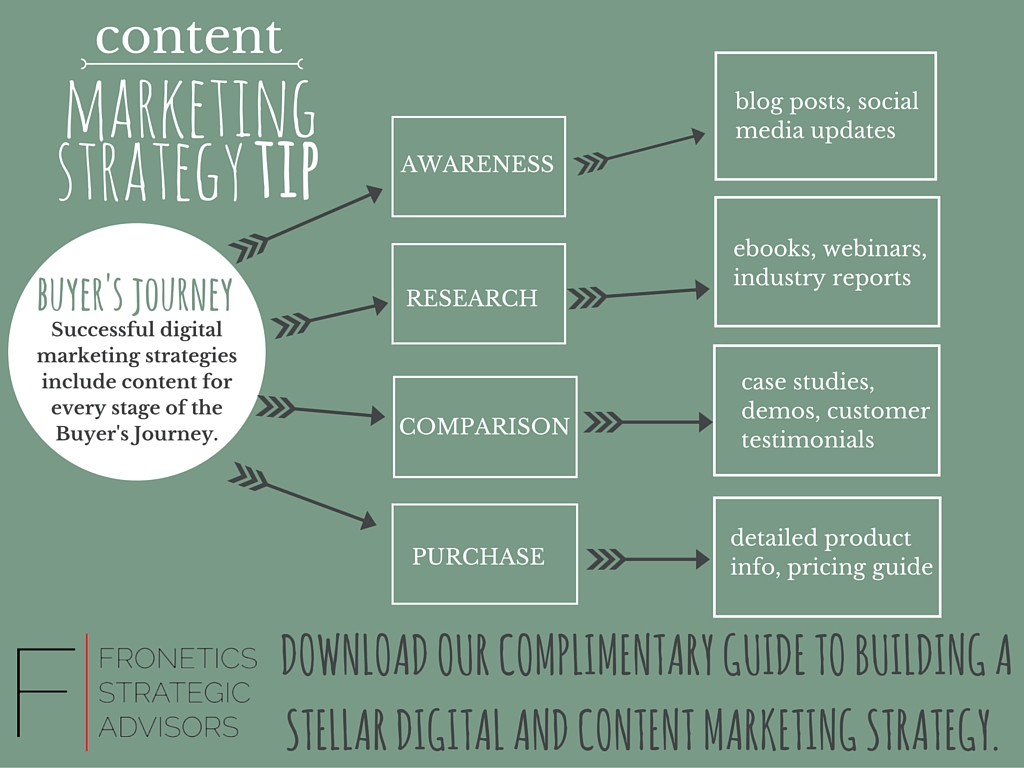
by Fronetics | Sep 6, 2016 | Blog, Content Marketing, Logistics, Marketing, Strategy, Supply Chain
Your customers use vendor content in their purchasing decisions, and you need a strategy to reach them — or your competitors will.
Content marketing can be a game-changer, in terms of new business and sales revenue, for organizations of all sizes and industries and levels of marketing savvy. But you can’t just set up a blog and a few social media accounts and expect sales numbers to start shooting through the roof.
The truth is, your potential customers consider vendor content in the purchasing process. If you don’t have a data-driven content marketing strategy to attract their business, you’ll lose them to your competitors.
Sometimes, the numbers say it best. Here are 12 content marketing strategy statistics that underscore the importance of developing a clear content marketing strategy to advance your business goals.
12 content marketing strategy statistics
Your customers want content.
95% of B2B buyers are willing to consider vendor-related content as trustworthy. (DemandGen Report – 2016 Content Preferences Survey)
47% of B2B buyers consume 3-5 pieces of content prior to engaging with a salesperson. (DemandGen Report – 2016 Content Preferences Survey)
51% of B2B buyers rely more on content to research and make B2B purchasing decisions than they did a year ago. (DemandGen Report – 2016 Content Preferences Survey)
Type of content buyers have used in the past 12 months to make B2B purchasing decisions:
- White Papers (82%)
- Webinars (78%)
- Case studies (73%)
- eBooks (67%)
- Blog posts (66%)
- Infographics (66%)
- Third-party/Analyst reports (62%)
- Video/Motion graphics (47%)
- Interactive presentations (36%)
(DemandGen Report – 2016 Content Preferences Survey)
It’s important to clearly define your strategy and goals.
Content marketing effectiveness increases with:
- Experience (64% of experienced marketers say they are effective)
- A documented content marketing strategy (48%)
- A documented editorial mission statement (49%)
- Organizational clarity on what content marketing success looks like (55%)
- Daily or weekly content marketing meetings (41%)
(Content Marketing Institute/MarketingProfs)
Only 13% of those who do not document their strategy feel their content marketing is effective. (Content Marketing Institute/MarketingProfs)
Your strategy should clearly define your target audience and their needs.
96% of B2B buyers say content that speaks directly to their company is the single-most influential aspect of a vendor’s website. (Demand Gen 2016 B2B Buyer’s Survey Report)
What makes content most effective?
- Audience relevance (58%)
- Engaging and compelling storytelling (57%)
- Triggers a response/Action (54%)
(LinkedIn Technology Marketing Community)
Your competitors are using content to win over potential customers.
88% of B2B organizations in North America use content marketing. (Content Marketing Institute/MarketingProfs)
75% of marketers are increasing investment in content marketing. (Curata)
79% of logistics and supply chain companies consider content as an effective tool for their business. (Fronetics)
The marketing software market is expected to grow to more than $32.3 billion in 2018. (IDC)
Related posts:

by Fronetics | Aug 29, 2016 | Blog, Content Marketing, Logistics, Manufacturing & Distribution, Marketing, Strategy, Supply Chain, Warehousing & Materials Handling
Fronetics designed a content marketing strategy that helped the logistics software company realize increases in new business and sales revenue.
Your company is doing pretty well. You have a nice website and a social media account or two. And you’ve experienced year-over-year growth. Why would you do anything differently?
Just ask TotalTrax, a provider of real-time vehicle, driver, and inventory tracking technologies for manufacturing and warehouse operations. Despite a decade of positive growth, the company realized there were many untapped opportunities for new business. So the TotalTrax team hired Fronetics Strategic Advisors to create and implement a new, data-driven marketing strategy that could increase web traffic, lead generation, and brand awareness.
After a comprehensive audit of TotalTrax’s digital assets, Fronetics was able to recommend a course of action and implement a multi-channel content marketing program. The program included such steps as:
- Creating a blog and posting regular targeted content
- Consistently posting on TotalTrax’s social media accounts
- Implementing paid search, email marketing, and other strategies
After just 24 months, TotalTrax realized significant gains in web traffic, lead generation and nurturing, and — most importantly — new business and sales revenue.
To learn more about how content marketing helped TotalTrax grow business, download our case study below.

Related posts:

by Fronetics | Jun 16, 2016 | Blog, Content Marketing, Manufacturing & Distribution, Marketing, Strategy, Supply Chain

A recent report produced by the Content Marketing Institute and MarketingProfs, and sponsored by Brightcove, found that 81% percent of B2B manufacturers in the United States use content marketing. The same report found that the majority of manufacturers do not believe their organization is effective at content marketing.
What are organizations who are not effective missing out on? A lot.
An effective content marketing strategy can:
- Build brand awareness
- Position your company as a thought leader within the industry
- Increase engagement with customers, partners, and stakeholders
- Educate and inform customers, partners, and stakeholders
- Build trust
- Allow you to manage your reputation
- Generate leads
How can your organization realize these benefits?
The first step is documenting your strategy. The report found that organizations with a documented strategy in place were 3x more likely to report that their content marketing strategy was effective than organizations without a documented strategy.
Define your goals
Why does your company want to create content? Do you want to shorten your sales cycle? Increase leads? Build brand awareness? You don’t want your content to be just stuff. You don’t want content to be ineffective. Therefore it is important to define what it is you want your content to do for your company.
Define your audience
Who is your target audience? What are their needs? What are their goals? What are their pain points? What do they value most? Where do they go for information? Take your time. Be honest. If you identify and define your audience correctly you will be more likely to reach your target audience and engage them than if you get this step wrong.
Define your metrics
Determine how you are going to track and measure success. Define the metrics that you will track on a daily, weekly, monthly, and yearly basis.
Identify the right distribution channels
When it comes to content, distribution is essential – your content will not reach your target audience and will not be read unless it is distributed. Take the time to identify the distribution channels that are right fit for your company, your content, and your goals.
Create a publishing calendar
A publishing or editorial calendar provides you with a framework to create and distribute content. It helps you create content that is consistent, that is quality, and is tailored to your company’s goals. It is also helpful in terms of managing workflows, meeting deadlines, and managing writer’s block.
Create content
Valuable and relevant content is not a sales pitch. It is not content that pushes your products and services. Rather, it is content that communicates valuable information to customers and prospects so that they have the knowledge to make better informed decisions. Moreover, it is content that establishes your business as a reliable source of knowledge – as the thought-leader within the industry. Be thoughtful when you create content.
Curate content
Content will help you grow your business; by creating and distributing valuable and relevant content in a strategic and consistent manner you can drive profitable customer action. But, it’s not all about you. It’s not all about the content you and/or your business creates. Here’s why content curation is an essential component of a successful content strategy. The internet is a fire hose stream of content. Being able to navigate the deluge of content and identify the content that is valuable to your customers and to your business is essential. The process of identifying and sharing this content is content curation. By consistently being able to identify, make sense of, and share content that is important and relevant to your customers and to your industry you will establish your business as a thought leader and a trusted resource.
Distribute content
Distribute your content via your target distribution channels. Distribute the content consistently over time and at the right time.
Engage with customers and prospects
Once your content has been distributed, engage with your audience. Respond to comments, respond to questions, and provide clarification. Make your content more than words – make it a relationship.
Track and analyze metrics
Track and analyze your metrics on a daily, weekly, monthly, and annual basis. Take a look at what is working and what is not. By tracking and analyzing your metrics you can see, for example, what type of content is most effective and which distribution channels are helping you achieve your goals.
Make adjustments as needed
Your strategy should not be set in stone. Your strategy should be flexible. Look at your metrics, look at the feedback you are getting through your engagement with customers and prospects – make adjustments to your strategy as needed. Remember that when it comes to content it is important to think marathon not sprint. An effective content strategy requires patience and determination. Many companies make the mistake of giving up on a content strategy too early; make a long-term commitment to your strategy.
This post originally appeared on Electronics Purchasing Strategies.
You may also like:


by Fronetics | Jan 20, 2016 | Blog, Content Marketing, Marketing, Strategy
Grow your business with this 12-step guide to creating a content marketing strategy.

So, you’ve decided to give content marketing a go, but you’re not sure where to start. Or, maybe you have tried implementing some of the basic principles but haven’t had much success with your piecemeal approach.
Either way, without a documented strategy in place, you’re much less likely to reap the potentially enormous benefits inbound marketing can offer.
In fact, only 11% of companies without a documented content marketing strategy find their efforts to be successful, compared to 60% of companies with a strategy in place. And that number rises to 86% when the company designates someone to lead the strategy. The numbers speak for themselves.
Fronetics Strategic Advisors has developed a 12-step guide to developing a content marketing strategy specifically tailored to your business. This eBook provides insight into what makes good content, as well as tried-and-true measures your company can take to get the most out of your marketing efforts. By following these recommendations, you’ll be well on your way to developing a strategy that drives profitable customer action and helps you meet your business goals.

Related articles:
When it comes to marketing we work with our clients to create and execute strategies that drive success and elevate their brand position within the industry. Unlike other firms, we align marketing programs with business objectives and, through a data driven approach, are able to deliver results with a targeted ROI. Our team is comprised of strategists, marketing professionals, writers, designers, and experts in social media. Together we leverage our experience to increase brand awareness, position our clients as thought leaders, drive meaningful engagement with prospects and customers, and help businesses grow. Learn more about what we do.
![How to create an effective content strategy [Template]](https://fronetics.com/wp-content/uploads/2024/10/content-strategy-1024x675.jpg)
by Fronetics | Oct 26, 2015 | Blog, Content Marketing, Marketing, Strategy
With 3 out of 4 marketers across the globe prioritizing content marketing, producing unique content to attract and convert website visitors can be tough. From social media to blog posts to ebooks and webinars, buyers are accessing your content through a myriad of channels. The amount and frequency of content to create can be dizzying. Fortunately, by starting with a solid strategy you can assure your content flows freely and your marketing content stands out.
One key element of any successful content strategy is mapping your buyer’s journey. Considering the path of purchase of current customers can give you valuable insight into the stages that a lead goes through before becoming a customer. Typically, buyers follow a track that looks something like this: awareness, research, consideration, and purchase. Knowing your buyer’s journey can inform your decisions about what kinds of content will resonate with your prospects and which channels of distribution will be most successful connecting them to your content.

Of course, just mapping out your Buyer’s Journey won’t lead to content marketing success. It’s certainly important, but it should be one component in your overall strategy. Start building a comprehensive content strategy that includes goal setting, developing buyer personas, setting keywords, and brainstorming content topics by using our free Content Strategy Template. You’ll be well on your way to creating great content and attracting even better leads.

You may also like:
Fronetics Strategic Advisors is a leading management consulting firm. Our firm works with companies to identify and execute strategies for growth and value creation.
We advise and work with companies on their most critical issues and opportunities: strategy, marketing, organization, talent acquisition, performance management, and M&A support.










![How to create an effective content strategy [Template]](https://fronetics.com/wp-content/uploads/2024/10/content-strategy-1024x675.jpg)

